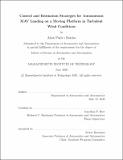| dc.contributor.advisor | Jonathan P. How. | en_US |
| dc.contributor.author | París i Bordas, Aleix. | en_US |
| dc.contributor.other | Massachusetts Institute of Technology. Department of Aeronautics and Astronautics. | en_US |
| dc.date.accessioned | 2020-09-03T17:45:57Z | |
| dc.date.available | 2020-09-03T17:45:57Z | |
| dc.date.copyright | 2020 | en_US |
| dc.date.issued | 2020 | en_US |
| dc.identifier.uri | https://hdl.handle.net/1721.1/127080 | |
| dc.description | Thesis: S.M., Massachusetts Institute of Technology, Department of Aeronautics and Astronautics, May, 2020 | en_US |
| dc.description | Cataloged from the official PDF of thesis. | en_US |
| dc.description | Includes bibliographical references (pages 67-74). | en_US |
| dc.description.abstract | Micro aerial vehicles (MAVs) are increasing in popularity both for recreational and commercial purposes. In particular, autonomous MAVs are promising in the field of drone delivery due to their scalability, deployability, and low cost compared to traditional ground delivery. Hybrid systems, which combine MAVs taking off and landing from/to trucks and the ground vehicles themselves to increase package delivery efficiency, present even more advantages. Nevertheless, these systems require reliable control strategies that account for the challenging environment present in the vicinity of moving ground vehicles, as well as techniques to estimate these conditions. This thesis presents a novel planning and control strategy that allows a fast, autonomous landing of a micro aerial vehicle (MAV) on a moving ground vehicle, which will be required for truck-drone delivery systems. The turbulent wind conditions near the landing platform are measured online using small, inexpensive whisker-like sensors. The measurements from these sensors are then used by an unscented Kalman filter to estimate the wind speed acting on the MAV, which is then compensated for by a boundary layer sliding controller. The experiments performed validate the robustness of the approach, which allows fast, dynamic landings of a MAV in moving ground vehicles in challenging environments without the need for hovering above the landing platform first. | en_US |
| dc.description.statementofresponsibility | by Aleix París i Bordas. | en_US |
| dc.format.extent | 74 pages | en_US |
| dc.language.iso | eng | en_US |
| dc.publisher | Massachusetts Institute of Technology | en_US |
| dc.rights | MIT theses may be protected by copyright. Please reuse MIT thesis content according to the MIT Libraries Permissions Policy, which is available through the URL provided. | en_US |
| dc.rights.uri | http://dspace.mit.edu/handle/1721.1/7582 | en_US |
| dc.subject | Aeronautics and Astronautics. | en_US |
| dc.title | Control and estimation strategies for autonomous MAV landing on a moving platform in turbulent wind conditions | en_US |
| dc.type | Thesis | en_US |
| dc.description.degree | S.M. | en_US |
| dc.contributor.department | Massachusetts Institute of Technology. Department of Aeronautics and Astronautics | en_US |
| dc.identifier.oclc | 1191824022 | en_US |
| dc.description.collection | S.M. Massachusetts Institute of Technology, Department of Aeronautics and Astronautics | en_US |
| dspace.imported | 2020-09-03T17:45:57Z | en_US |
| mit.thesis.degree | Master | en_US |
| mit.thesis.department | Aero | en_US |
